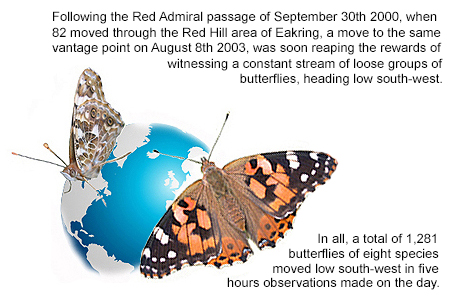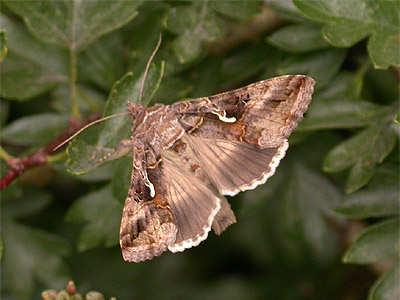

| Migrant butterflies move through in numbers August 2003 | ||
| ... | ||
 |
An exciting
spectacle of well over a thousand butterflies, moved
through the Red Hill area of Eakring, from mid-morning
onwards on August 3rd 2003. It initially began with the odd Painted Lady occasionally being noted moving south-west across open, cultivated fields in the Eakring Flash area. Scanning with binoculars soon revealed Painted Ladies and the occasional Red Admiral moving through at a steady rate of about one every few minutes. Following the good Red Admiral passage of September 30th 2000, when 82 moved through the Red Hill area, the move to the same vantage point was soon reaping the rewards of witnessing a constant stream of loose groups of butterflies, heading low over the cereal fields south-west. |
|
| ... | ||
| Most were Painted Ladies,
but a real personal surprise was that this movement incorporated seven
additional species, most not noted for their migratory tendencies. Biggest surprise was the total of 106 Peacock and 47 Small Tortoiseshell, all following the same direction as the primary movers - 716 Painted Lady, 179 Large White and 134 Red Admiral. In all, a total of 1,281 butterflies of eight species moved low south-west in 5 hours observations. The table produced below, shows the accumulated totals from the two vantage points used and during the times given. |
||
| ... | ||
| Date 03/08/03 | --- Eakring Flash --- | -------------------------- Red Hill ------------------------- | Total | ||
| Species | 10:30am-11:00am | 11:10am-13:10pm | 13:10pm-14:40pm | 14:40pm-15:40pm | ... |
| ... | |||||
| Painted Lady | 14 | 339 | 254 | 99 | 716 |
| Large White | 2 | 68 | 102 | 9 | 179 |
| Red Admiral | 2 | 50 | 75 | 9 | 134 |
| Peacock | . | 40 | 60 | 6 | 106 |
| Small White | 5 | 20 | 30 | 4 | 54 |
| Small Tortoiseshell | . | 16 | 24 | 7 | 47 |
| Green-veined White | . | 16 | 24 | 2 | 42 |
| Comma | . | 1 | 1 | 1 | 3 |
| ... | ||
| Peak movement
occured between 11:10am and 13:10pm, this conciding with
the change in vantage points. Situated along a small ridge of farmland, Red Hill lies just west of Eakring Flash. Immediately upon arrival there, it was clear that totals were going to be large. Group after group of Painted Ladies were flying past, with an average of 4/5 per group. The largest was 12 and several other 10+ groups were noted during the day. The highest single Red Admiral group noted was four. Other species involved throughout the day, produced a fairly constant trickle of ones and twos. The final hour's totals show how movement of all had dropped, but especially the whites. Every scan over the crops produced butterflies and counting became difficult at times if four or five species were involved. Scanning distance was approximately 100 metres either side of standing point. As mentioned before, most groups were loose, but occasionally several butteflies moved through with feet of each-other. Movement was constant from 11:10am-15:20pm, when counts became smaller, but Painted Ladies still occurred at the rate of about one per minute. The first period in the above table produced an average hourly rate of 169.5 Painted Ladies south-west. From 14:40pm, this average had dropped to 99 per hour. Continuous movement was also noted at Rutland Water during the day (per G Wilson) |
| ... | ||
| August
4th 2003 The following day saw much depleted (but again constant) movements through the area. The same eight species were involved but also noted were five Silver Y moths - all moving south-west. Painted Lady was again the commonest species recorded, but there was a difference in migration this morning. Many butterflies were coming in from the north-east and pausing to feed on the few flowers available. This never occurred the day before and may be suggestive as to the trigger point of this migration. Aside from the annual return migration undertaken by our regular migrant insects, possibly a general nectar shortage due to the dry Summer, has acted as the trigger for more unusual species to join the south-westerly movement? |
||
| ... |
 |
|
|||||||||||||||||||||||||||||
| ... | ||||||||||||||||||||||||||||||
| Although conditions were equally as favourable as August 3rd, it was soon clear that there was to be no repeat of that day's events. Late evening, Painted Lady butterflies were still passing through Bentinck pit top at a rate of one every ten minutes. (per G Wilson) | ||||||||||||||||||||||||||||||
| ... | ||||||||||||||||||||||||||||||
|
August 6th Painted Ladies continued to move south-west, with adults going through at a rate of just under 80 per hour, until movement slowed dramatically during the hottest part of the day at around midday. The other seven species noted recently on migration were few in number this morning. Prior to this, movement was in excess of those observed on August 4th. A total of 94 Painted Ladies went south-west in just over an hours observation. With temperatures hovering around 30C, moisture availability seems to be low. Many butterflies (especially the whites) are presently feeding on salts and obtaining moisture from mud around Eakring Flash. This is commonly observed in hot countries around the world. |
|||||||||||||||||||||||
| ... | ||
| Summary
of the event The event was a surprise (especially the scale of it) and the fact that it took place much earlier in the month than I had anticipated any movement as being likely. The event was reported in the local press, but although the passage coincided with a period of very hot, anticyclonic weather - it was incorrectly reported that these butterflies were of recent Continental origin. They were in fact the result of butterflies hatching in more northern areas of the UK and returning south. This was allowed for by the extremely favourable weather conditions, after an arrival which had taken place several months earlier in May. Because of the very dry conditions at the time, it may also have been induced by the considerable lack of moisture. During August, it became a very common sight to see many butterflies obtaining water and minerals from the mud around Eakring Flash, something I have rarely observed before in the UK. Movements continued throughout August and well into September, but the Painted Lady/Red Admiral ratio changed over that period. When Painted Lady counts were scaled up for the entire width of the recording area between it's widest points; then it is likely that with recorders stationed 200 metres apart, they would have recorded well in excess of 12,500 Painted Ladies. Quite a staggering figure, yet most likely a minimum one for the five hour period. The same rule applied to all eight species, would be 23,000 butterflies. The movements of Peacock and Small Tortoiseshell were interesting to note. Earlier in the Spring, I had noticed occasional adults of both species moving north through the area in direct and purposeful fashion. Lack of any documentation about these species' migration tendencies, saw me dismiss them as being migrants at the time. |